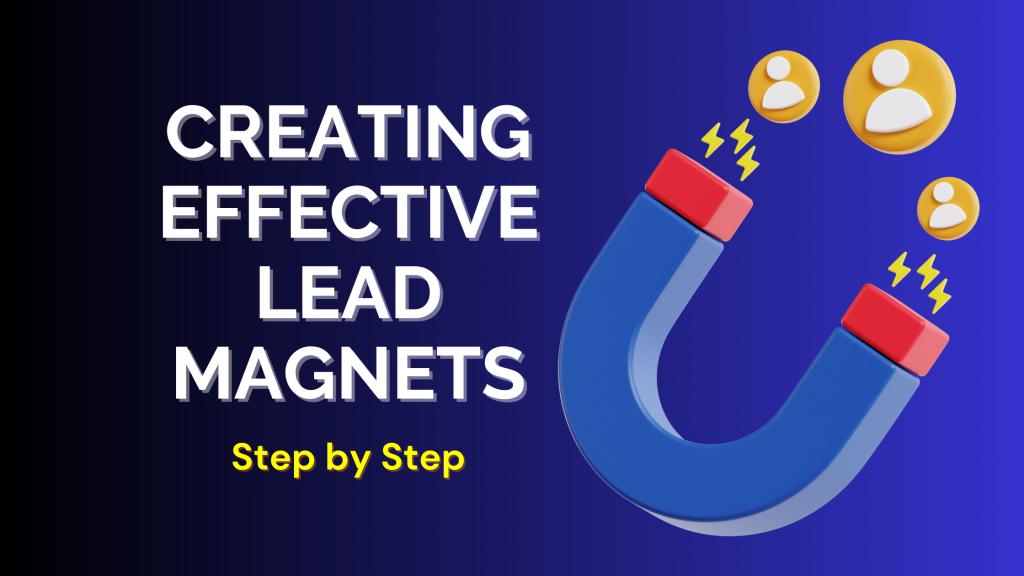Are you struggling to attract leads to your business? If so, you need to start using lead magnets.
Lead magnets are freebies that you give away in order to capture the attention of potential customers. Once you have their attention, you can start to nurture them and convert them into paying customers.
In this article, we’re going to show you how to create highly effective lead magnets that will help you attract more leads and convert more of them into customers.
Table Of Content.
- What is a Lead Magnet?
- How to Create an Effective Lead Magnet
- Optimizing Your Lead Magnets
- Measuring the Effectiveness of Your Lead Magnets
What is a Lead Magnet?
It’s a valuable piece of content or offer that is provided to potential customers in exchange for their contact information, such as their email address.
It is an incentive designed to attract and capture leads, with the ultimate goal of turning them into paying customers.
They can come in various formats, including ebooks, whitepapers, checklists, templates, webinars, free trials, and exclusive discounts.
Not only does it provide immediate value to the audience, but it also serves as the first step in building a relationship with potential customers.
By offering something of value, you are able to establish trust and demonstrate your expertise in your field. It’s important to ensure that your lead magnet is relevant to your target audience’s needs and interests, as this will increase the chances of converting them into qualified leads.
Here are some examples of effective lead magnets:
1. The Ultimate Guide to Social Media Marketing: A comprehensive ebook that provides step-by-step instructions on how to create a successful social media strategy.
2. 10 Templates for Email Marketing Campaigns: A set of ready-to-use email templates that help businesses improve their email marketing efforts.
3. Free Website Audit Checklist: A downloadable checklist that allows website owners to identify and fix common website issues for better performance and user experience.
Key takeaway: A lead magnet is a valuable incentive offered to potential customers in exchange for their contact information. It helps establish trust and build relationships with your target audience while positioning yourself as an expert in your industry.
Different Types of Lead Magnets
When it comes to creating effective lead-magnets, it’s important to consider the different types of lead magnets that can capture the attention and interest of your target audience. Here are some popular types of lead magnets that you can leverage:
1. Ebooks and Guides: Providing valuable, in-depth information on a specific topic is a great way to attract leads. Ebooks and guides can be comprehensive resources that address common pain points or offer practical solutions.
2. Checkand Cheat Sheets: These types of lead-magnets are quick and easy to digest, providing a concise list of actionable steps or key points related to a specific topic. They offer a handy reference tool for your audience.
3. Templates and Swipe Files: Offering ready-to-use templates or swipe files can save your audience valuable time and effort. These resources provide practical solutions and can be customized to fit specific needs.
4. Webinars and Online Courses: Hosting webinars or offering online courses allows you to showcase your expertise and provide valuable educational content. These interactive options enable direct engagement with your audience.
5. Free Trials and Demos: For products or services, providing a free trial or demo allows potential customers to experience the value firsthand. This helps build trust and confidence in your offerings.
6. Quizzes and Assessments: Quizzes and assessments provide personalized insights to your audience. By offering a self-assessment or quiz related to your industry, you can engage your audience and provide tailored recommendations.
Remember, the key to creating an effective lead-magnet is to align it with the needs and preferences of your target audience. Choose a type of lead magnet that resonates with them and provides genuine value.
💡 key Takeaway: To effectively capture and convert leads, consider various types of lead magnets such as ebooks, checklists, templates, webinars, free trials, and quizzes. Choose the type that aligns with your audience’s needs and preferences.
How to Create an Effective Lead Magnet
Step 1 – Identifying Your Target Audience
To create an effective lead magnet, it’s crucial to understand and identify your target audience.
This step lays the foundation for developing content that resonates with and attracts your ideal customers. Here’s how you can go about identifying your target audience:
1. Conduct Market Research: Start by researching your industry and target market. Look for demographic information, such as age, gender, location, and income level. Additionally, identify their pain points and preferences related to your product or service.
2. Create Buyer Personas: Once you have gathered data, create buyer personas to represent different segments of your target audience. A buyer persona is a fictional representation of your ideal customer, including their characteristics, goals, and challenges. This will help you better understand their needs and craft tailored content.
3. Analyze Competitors: Study your competitors’ target audience and see how they engage with them. Pay attention to the type of content they create and the platforms they use to reach their audience. This analysis will provide insights on gaps and opportunities for you to differentiate yourself.
4. Use Analytics Tools: Leverage analytics tools such as Google Analytics and social media insights to gather data about your existing audience. Identify patterns, interests, and behaviors that can help refine your target audience.
By thoroughly identifying your target audience, you will be able to create a lead magnet that speaks directly to their needs and interests. This targeted approach increases the likelihood of capturing and converting leads effectively.
💡 key Takeaway: Identifying your target audience is a critical step in creating an effective lead magnet. Conduct market research, create buyer personas, analyze competitors, and use analytics tools to gain a deep understanding of your ideal customers. Tailoring your lead magnet to their needs and interests will increase your chances of success.
Step 2 – Creating Unique Content
In order to create an effective lead magnet, it’s important to focus on generating unique content that provides value to your target audience.
Your lead magnet should offer something that is not readily available elsewhere, making it enticing and irresistible for your visitors to opt in and provide their contact information.
1. Identify your target audience: Before you begin creating your lead magnet, it’s crucial to have a clear understanding of who your target audience is. Research their needs, pain points, and desires, so that you can tailor your content specifically to address their challenges.
2. Offer valuable information or resources: Your lead magnet should offer high-quality content that educates or solves a problem for your audience. This could be in the form of a comprehensive guide, a checklist, a webinar, or an exclusive video series. The key is to provide information that is actionable and immediately useful to your readers.
3. Be creative and innovative: To stand out from the competition, think outside the box and come up with unique angles or approaches to your lead magnet content. Offer insights or strategies that are fresh and original, giving your audience a reason to choose your lead magnet over others.
4. Demonstrate your expertise: Include examples, case studies, or success stories that showcase your knowledge and expertise in the topic. This helps establish your authority and builds trust with your audience, increasing the chances of them converting into leads.
5. Keep it concise and valuable: While it’s important to provide comprehensive information, it’s equally important to keep your lead magnet concise and to the point. Avoid overwhelming your audience with too much information. Instead, focus on delivering maximum value with minimal fluff.
“The key to creating unique content for your lead magnet is to provide valuable information that is tailored to the specific needs of your target audience. By offering innovative solutions, demonstrating expertise, and keeping it concise, you can create a lead magnet that truly stands out and converts leads effectively.”
💡 key Takeaway: Creating unique content for your lead magnet involves identifying your target audience, offering valuable resources, being creative and innovative, demonstrating expertise, and keeping the content concise yet valuable.
You can also check out this Demo Video from one software called Sqribble for Creating Lead Magnets
Step 3 – Designing an Appealing Landing Page
A key aspect of creating an effective lead magnet is designing a visually appealing and user-friendly landing page. Here are some essential elements to consider:
1. Clear and Concise Headline: Your headline should grab the reader’s attention and clearly convey the value proposition of your lead magnet. Use persuasive language to entice visitors to opt-in.
2. Engaging Copy: Beyond the headline, the copy on your landing page should highlight the benefits of your lead magnet. Focus on how it solves a specific problem for your target audience. Use bullet points and short paragraphs to make the content easily scannable.
3. High-Quality Images and Visuals: Incorporating relevant and high-quality images or graphics can significantly enhance the visual appeal of your landing page. Visuals can capture attention and convey your message quickly.
4. Simple Opt-In Form: Keep the opt-in form short and simple, asking for only essential information such as name and email. A lengthy form can deter visitors from signing up.
5. Strong Call-to-Action (CTA): Your CTA should be compelling and clearly guide users to take action. Use action-oriented language and design the CTA button in a contrasting color to make it stand out.
6. Trustworthy Testimonials: Including testimonials from satisfied customers can boost credibility and trust in your lead magnet. Use quotes that highlight the positive outcomes or results others have experienced.
7. Mobile Optimization: Ensure your landing page is fully optimized for mobile devices. A significant portion of users accesses the internet via mobile, and an optimized landing page will provide a seamless user experience.
💡 key Takeaway: Designing an appealing landing page is crucial for the success of your lead magnet. A visually captivating page with persuasive copy, clear CTAs, and trust-building elements can significantly increase the conversion rate of your leads.
Optimizing Your Lead Magnet
To maximize the effectiveness of your lead magnet and ensure it reaches a wider audience, it’s essential to optimize your strategies. Here are some key steps you can take to optimize your lead magnet:
1. Leveraging Social Media: Utilize social media platforms to promote your lead magnet. Share teaser content, create engaging posts, and encourage your audience to sign up for your lead magnet. Leverage relevant hashtags and engage with your followers to increase visibility and reach.
2. Utilizing SEO: Implementing SEO strategies can significantly boost the visibility and organic reach of your lead magnet. Conduct keyword research to identify relevant keywords and incorporate them naturally into your lead magnet content. Optimize your landing page with meta tags, header tags, and descriptive URLs to improve search engine rankings.
3. Streamlining the User Experience: Ensure a seamless user experience by optimizing your lead magnet’s landing page. Make sure the page loads quickly, is mobile-friendly, and has clear and concise copy that highlights the value proposition of your lead magnet. Use compelling visuals, such as images, videos, or infographics, to enhance engagement and encourage sign-ups.
4. A/B Testing: Experiment with different versions of your lead magnet and landing page to identify the most effective elements. Test different headlines, calls-to-action, and visuals to determine which combination yields the highest conversion rates. Continuous testing and optimization will help you refine your lead magnet strategy over time.
💡 key Takeaway: Optimizing your lead magnet is crucial for maximizing its reach and impact. By leveraging social media, utilizing SEO, streamlining the user experience, and conducting A/B testing, you can enhance your lead magnet’s visibility, attract more leads, and ultimately increase conversions.
Leveraging Social Media
Social media platforms have become powerful tools for reaching a wide audience and promoting your lead magnet effectively. Here are some strategies to leverage social media for maximum impact:
1. Choose the right platforms: Identify the social media platforms where your target audience is most active. Focus your efforts on those platforms to ensure you’re reaching the right people.
2. Craft compelling posts: Write engaging captions and headlines that grab attention and entice users to click on your lead magnet. Use enticing language, intriguing questions, or compelling statistics to pique curiosity.
3. Use eye-catching visuals: Incorporate eye-catching images, videos, or infographics in your social media posts to make them more visually appealing and shareable. Visual content tends to attract more attention and can increase your chances of driving traffic to your lead magnet.
4. Leverage influencers: Collaborate with relevant influencers or thought leaders in your industry to widen your reach and gain credibility. Influencers can promote your lead magnet to their followers, exposing it to a larger audience and increasing its chances of being shared.
5. Run targeted ads: Utilize the ad targeting capabilities offered by social media platforms to ensure that your lead magnet reaches the right audience. Narrow down your targeting based on demographics, interests, and behaviors to maximize the effectiveness of your ads.
6. Engage with your audience: Respond to comments, messages, and mentions on social media promptly. Engage in conversations, address queries, and build relationships with your audience. This helps in establishing trust and credibility, making it more likely for users to download your lead magnet.
7. Share user-generated content: Encourage your audience to generate content related to your lead magnet and share it on social media. User-generated content provides social proof and enhances the trustworthiness of your lead magnet.
💡 key Takeaway: Leveraging social media is a crucial part of promoting and driving traffic to your lead magnet. By choosing the right platforms, crafting compelling posts, utilizing eye-catching visuals, collaborating with influencers, running targeted ads, engaging with your audience, and encouraging user-generated content, you can significantly increase the reach and impact of your lead magnet.
Utilizing SEO to optimize your lead magnet
When it comes to creating an effective lead magnet, optimizing it for search engines can greatly enhance its visibility and reach. Here are some strategies to effectively utilize SEO for your lead magnet:
1. Keyword Research: Start by conducting thorough keyword research to identify the relevant keywords and phrases that your target audience is searching for. Use tools like Google Keyword Planner or SEMrush to discover high-volume and low-competition keywords that you can incorporate into your lead magnet content.
2. On-Page Optimization: Once you have your keywords, optimize your lead magnet by strategically placing them in the title, headings, subheadings, and throughout the content. Remember to keep the content natural and avoid keyword stuffing, as it can have a negative impact on user experience and search engine rankings.
3. Meta Tags: Craft compelling meta titles and descriptions that accurately reflect the content of your lead magnet. These meta tags serve as the preview text in search engine results, so make them informative and enticing to encourage clicks and engagement.
4. URL Structure: Optimize your lead magnet’s URL by including relevant keywords. A clean and descriptive URL structure not only helps search engines understand the content better but also provides users with a clear idea of what they can expect.
5. Internal and External Linking: Incorporate relevant internal links within your lead magnet to guide users to other valuable resources on your website. Additionally, aim to build high-quality backlinks from reputable websites by reaching out to industry influencers or guest posting, as this can significantly improve your lead magnet’s search engine rankings.
6. Mobile Responsiveness: With the majority of internet users browsing on mobile devices, it’s crucial to ensure that your lead magnet is fully optimized for mobile screens. Responsive design not only enhances user experience but also improves your chances of ranking higher in mobile search results.
💡 key Takeaway: By leveraging SEO techniques such as keyword research, on-page optimization, meta tags, URL structure, internal and external linking, and mobile responsiveness, you can significantly enhance the visibility and discoverability of your lead magnet, ultimately increasing your chances of capturing and converting leads.
Measuring the Effectiveness of Your Lead Magnet
Once you have created your lead magnet and launched it, it’s crucial to measure its effectiveness to ensure you’re getting the desired results. To help you evaluate the performance of your lead magnet, here are some key metrics and strategies you can use:
1. Tracking Lead Conversion Rates
– Implement tracking mechanisms such as UTM codes and conversion pixels to monitor how many leads are converting from your lead magnet.
– Use analytics tools like Google Analytics to analyze the conversion rates and track the effectiveness of your lead magnet over time.
2. Analyzing Lead Quality
– It’s not just about quantity; the quality of leads generated by your lead magnet matters too. Assess the quality of leads by evaluating factors such as engagement, intent, and their likelihood to convert into customers.
– Consider using lead scoring techniques to assign values to leads based on their behavior, demographics, and other relevant factors.
3. Solicit Feedback
– Reach out to the leads who have engaged with your lead magnet and ask for their feedback. Use surveys, interviews, or customer reviews to gather insights on their experience with the lead magnet.
– Pay attention to their comments, suggestions, and pain points, as this feedback will help you refine and improve your lead magnet.
4. A/B Testing
– Conduct A/B tests to compare different variations of your lead magnet, such as different headlines, designs, or lead capture forms.
– Split your audience into two groups and measure their responses to each variation to determine which one performs better and generates higher conversion rates.
💡 key Takeaway: Measuring the effectiveness of your lead magnet is essential for optimizing your lead generation efforts. Tracking conversion rates, analyzing lead quality, soliciting feedback, and conducting A/B tests will help you refine your lead magnet strategy and maximize its impact.
Tracking Lead Conversion Rates
One of the key aspects of creating an effective lead magnet is to track the conversion rates of your leads. This allows you to measure the success of your lead magnet campaign and make necessary improvements. Here are some important steps to track lead conversion rates:
1. Set Up Conversion Tracking: Utilize tools like Google Analytics or other marketing automation platforms to set up conversion tracking on your landing page. This will help you track how many visitors are converting into leads.
2. Define Conversion Goals: Determine what constitutes a conversion for your business. It could be signing up for a newsletter, downloading an eBook, or filling out a contact form. Clearly define these goals in your tracking setup.
3. Track Your Traffic Sources: Identify the sources of your website traffic and track which sources are driving the most conversions. This information will help you optimize your marketing efforts and allocate resources accordingly.
4. Monitor Conversion Rates Over Time: Regularly monitor your conversion rates to identify any trends or patterns. Analyze the data to understand what is working well and what needs improvement.
5. A/B Testing: Conduct A/B tests to compare the performance of different lead magnets or variations of your landing page. This will provide insights into which elements are more effective at converting leads.
6. Analyze Lead Quality: Conversion rates alone do not provide the complete picture. You also need to assess the quality of the leads generated. Are they high-value leads that are likely to convert into customers? Use lead scoring methods to determine lead quality and adjust your lead generation strategy as needed.
💡 key Takeaway: Tracking lead conversion rates is crucial for evaluating the effectiveness of your lead magnet. It helps you identify opportunities for optimization and ensures that you are attracting high-quality leads.
Analyzing Lead Quality
When it comes to lead generation, the quality of your leads is just as important as the quantity. It’s essential to analyze the quality of the leads you receive through your lead magnet to determine the effectiveness of your overall lead generation strategy. Here are some key steps to analyze lead quality:
1. Define your lead criteria: Start by clearly defining what constitutes a qualified lead for your business. Consider factors such as demographics, interests, behaviors, and engagement levels. This will help you establish a baseline for evaluating lead quality.
2. Use lead scoring: Implement a lead scoring system to assign points to leads based on their engagement with your content, website, and interactions with your brand. This will help you identify the most promising leads and prioritize follow-up efforts.
3. Monitor conversion rates: Track the conversion rates of your leads into paying customers or the desired action (such as signing up for a newsletter). Compare the conversion rates of different lead sources or segments to understand which ones are delivering the highest-quality leads.
4. Analyze engagement metrics: Dive into engagement metrics such as email open rates, click-through rates, and time spent on your website. Higher engagement indicates stronger interest and suggests a higher likelihood of conversion.
5. Conduct customer surveys: Reach out to your customers and ask them about their experience with your lead magnet and their satisfaction with your offering. Gathering feedback directly from your audience allows you to gain insights into the perceived value and quality of your leads.
6. Continuously optimize: Use the insights gained from your analysis to refine and optimize your lead generation strategies. Adjust your targeting, content, and messaging to attract higher-quality leads and improve your overall conversion rates.
💡 key Takeaway: Analyzing lead quality is crucial for determining the effectiveness of your lead generation efforts. By defining lead criteria, implementing lead scoring, monitoring conversion rates and engagement metrics, conducting customer surveys, and continuously optimizing, you can improve the quality of your leads and boost conversion rates.
Conclusion
Conclusion If you’re looking to improve your lead conversion rate, you need to create lead magnets that are effective and engaging. A lead magnet is a valuable piece of content that you can use to capture and convert leads.
There are a few things that you need to keep in mind when creating a lead magnet. First, make sure that the content is easily digestible. Second, make sure that the content is relevant and interesting to your target audience. Third, make sure that the content is engaging and visually pleasing.
Once you have created the perfect lead magnet, you need to distribute it to your target audience. You can do this through email marketing, social media marketing or even content marketing campaigns. By using effective lead magnets, you can improve your lead conversion rate and boost your business growth.







